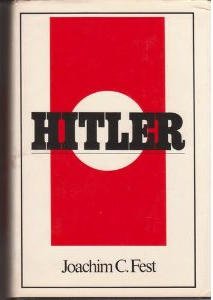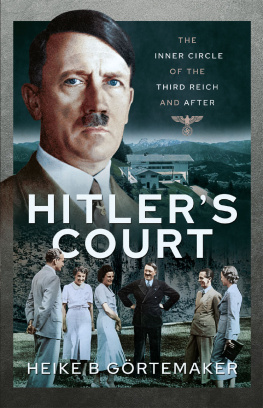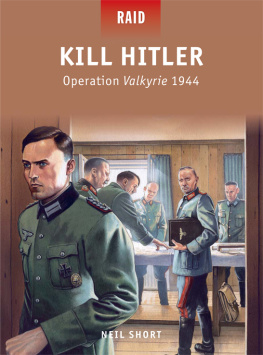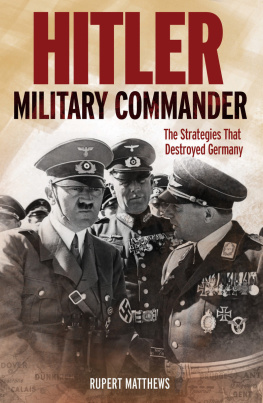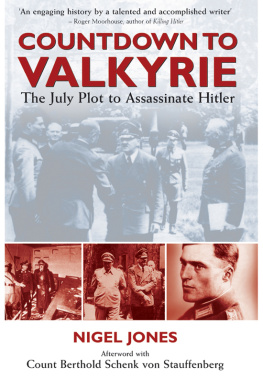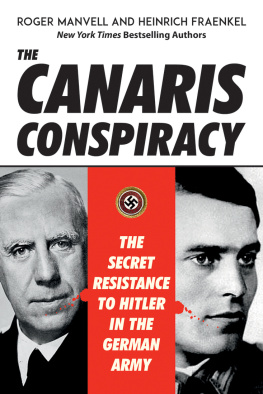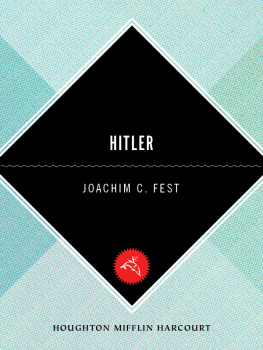PLOTTING HITLERS DEATH
The German Resistance to Hitler
19331945
By JOACHIM FEST
Translated by Bruce Little
On July 20, 1944, a powerful bomb ripped through Adolf Hitlers East Prussian headquarters during a briefing between the Fhrer and his senior officers. The bomb, planted by a dashing, highly decorated young count named Claus Schenk von Stauffenberg, blew pieces of wreckage and columns of smoke high in the air and completely destroyed the wooden barracks that housed the crowded briefing room. Although it miraculously failed to maim or kill Hitler, the explosion dramatically announced to the world the existence of a secret, indigenous opposition to the Nazi regime.
These events are, of course, quite familiar to most readers. But what is less widely known is that well before July 20 a substantial number of Germans had come to despise Hitler and his policies, even as the Fhrer racked up impressive victories at the ballot box and on the battlefield. This nascent opposition formed clandestine groups to help Hitlers victims escape from the country. Later, they plotted a coup dtat to rid Germany of Nazism and drafted plans for the society they wanted to create in place of the one they hoped to destroy. As many as fifteen assassination attempts were undertaken during the reign of National Socialism, but these efforts always failed: in some instances because of bad timing or poor planning; in others, because of the omnipresent scrutiny of the Gestapo or Hitlers own unerring instinct for danger.
It was only in the summer of 1944, when the wholesale defeat of the German army was already in sight, that the plot to kill Hitler finally came to fruition. The Allies had landed in Normandy a few weeks earlier, signaling a decisive turn in the direction of the war. This is why many historians have argued that Stauffenbergs bomb came too late to change the military and political course of the war, a fact of which the conspirators were only too well aware. Nevertheless, they wanted to send a message to the rest of the world that there had been men of principle in Germany who were prepared to lay down their lives to defeat Adolf Hitler.
There is ample reason to believe that the German resistance failed to achieve even this modest goal. The dark cloud of misfortune that hung over all of its endeavors has also cast a shadow on its historical legacy. Since the end of Hitlers reign many books have appeared on the subject-both in German and English-but none of these has managed lo provide a full understanding of the conspirators and their actions.1 The earliest accounts were personal reminiscences by resistance leaders who survived, such as Fabian von Schlabrendorff and Hans Bernd Gisevius, and extracts from the journals left by Ulrich von Hassel, a lawyer and diplomat executed in 1944. In 1948 an migr historian, Hans Rothfels, wrote his classic The German Opposition to Hitler: An Appraisal, the first comprehensive scholarly history. The subtle pathos of Rothfelss book derived from his desire to make the public in the Allied countries aware of the history of the opposition movement, a history that had been largely suppressed.
A series of memoirs by less well known members of the resistance followed soon after the release of Rothfelss book, as did the first attempts to assess the historical significance of the opposition (many of which tended to glorify their subject) and several scholarly works. During the 1960s a group of young historians published critical studies that examined the differing philosophies of the major resistance factions, as well as their clandestine dealings with the Allies. At about the same time the first significant biographies of the leaders of the resistance appeared. As the literature expanded, its scope broadened to include previously unknown opposition figures, as well as the diverse forms of political dissidence. Lastly, research into the resistance among workers brought entirely new themes and perspectives to light.
By now the flood of literature has become so vast, however, that it threatens lo submerge the real meaning and significance of the German opposition to National Socialism. Attention tends to focus on dramatic events like the idealistic and reckless actions of the White Rose, a group of students who distributed anti-Nazi leaflets in Munich; the courageous efforts of other groups are forgotten. Similarly, while the attempted coup dtat by a group of army officers on July 20, 1944, is quite well known, at least in its basic outline, little is remembered of the background: the various forces, motives, obstacles, and preparations that eventually culminated in Stauffenbergs deed. An undertaking of that sort is always more than a date and a sequence of events, and only a consideration of its historical context can reveal its meaning and importance.
Notwithstanding the celebrated events of July 20, the German public has long had difficulty acknowledging the resistance to Hitler and has never sufficiently appreciated the extent to which the existence of a relatively broad opposition helped ease Germanys acceptance back into the ranks of respectable nations. Foremost among the many reasons for this diffidence is the feeling-one deeply rooted in Germanys authoritarian heritage-that the opposition committed treason by abandoning the German people to its collective fate at a critical moment. This accusation has been leveled frequently and emphatically at opposition leaders like Brigadier General Hans Oster. Although it has been almost universally rejected in academic circles-no one charges Oster with deliberately seeking to harm his country-arguments such as this have done little to change received ideas and biases.
Perhaps a different approach to assessing the oppositions motives would succeed in convincing those who regard treason as an unpardonable offense. After several unsuccessful attempts to overthrow the regime, the conspirators sole remaining ambition by July 20, 1944, was to save as much of Germanys substance as possible from the impending catastrophe. Recent evidence proves how well founded their motives were: one study shows that, while slightly more than 2.8 million German soldiers and civilians died during the nearly five years between the beginning of the war on September 1, 1939, and the attempt to assassinate Hitler on July 20, 1944, 4.8 million died during the nine and a half months before the war ended in early May 1945. These figures appear even more shocking if we calculate how many were killed on average every day during those two periods. Before the attempted coup some 1,588 Germans were killed daily; after it 16,641-more than ten times as many-perished, even though the war had obviously been lost.2
To this human cost must be added the destruction visited upon cities, industry, and cultural treasures. The cities of Stuttgart, Darmstadt, Braunschweig, Wrzburg, Kiel, Hildesheim, Ulm, Mainz, Dresden, and Potsdam were all laid to ruin after the coup attempt, most of them having already suffered gravely in earlier bombing raids. The air war also continued virtually unimpeded against other cities, which were left defenseless following the complete collapse of German air power. Berlin did not suffer its most devastating attack until early 1945. Overall the destruction wrought in the last nine months of the war far exceeded that of the previous fifty-nine months, not to mention the countless casualties in other countries or the victims of Hitlers extermination policy, which continued to the very end.
One of the factors inhibiting appreciation of the German resistance has been the cacophony of voices in which it found expression. Opponents of the regime were motivated not only by a simple concern for human rights but also by Christian, socialist, conservative, and even reactionary beliefs. There is much truth to the claim that the German resistance to the Third Reich never existed in the sense of a unified group or movement sharing a common set of ideals.3 In fact, the term


